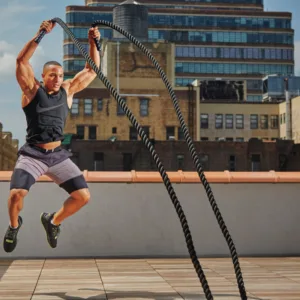Balance is an underrated principle of our everyday functioning. It keeps you upright, allows you to walk without assistance, and helps prevent injury. But there are a variety of things that can reduce our sense of balance, from both an internal and external perspective.
Simply explained, a good sense of balance allows us to recognize our position relative to other objects around us, including the surface on which we are standing, walking, or running. According to Caroline DeGroot, a physical therapist and the vestibular program manager at Athletico Physical Therapy, balance is an important aspect of carrying out both simple and complex movements.
“It allows you to perform everyday activities you may take for granted, like walking in open spaces without objects to hold onto or turning to talk to a friend while walking,” DeGroot said… “Balance also makes it possible to negotiate steps or curbs without a rail, walk on grass or sand, and step over obstacles.”
Related Articles: The Advantages/Disadvantages: “The Effects On The Body Of Doing Push-Ups” In A Daily Basis As A Workout Routine
And while it may be apparent when someone has particularly good (or bad) balance, there is actually much more happening internally than what we can see on the outside. Balance is maintained by the vestibular system, a small organ in the inner ear, and it can be negatively affected when the organ is damaged or not working correctly. This can happen in a number of ways, but the most common sources of declined balance are external substances and the aging process.
When people think about improving their physical fitness, they often overlook the issue of balance. That’s a critical oversight. Good balance is an integral part of being physically fit and key to living a long life, according to research. It’s an important issue for everyone, no matter their age.
Older adults are most affected by poor balance. Falls are the leading cause of injury and death for those 65 and older, with nearly 30% in this age group reporting at least one fall in 2018, according to the US Centers for Disease Control and Prevention. But younger adults frequently stumble, too.
Forty-eight percent of young adults reported falling at least once during one 16-week study. The tumbles most commonly occurred during walking and sports activities, with female participants in the study reporting more falls and fall-related injuries than males.
Falls within the previous two years were reported by 18% of young adults (ages 20 to 45) in another study published in the journal BMC Public Health. That figure compared with 21% of middle-aged adults (46 to 65) reporting falls and 35% of those over 65. While falls among young adults often correlated to participation in sports, stumbles by the middle-aged group were typically related to health issues and physiological changes.
Related Articles: The “7 Best Quadriceps Exercises” To Boost Legs Strength, Stability, Endurance, And Build Up Insane Muscle Size
Many factors can affect your balance outside of age, such as medication, vision changes, neuropathy of the feet, brain injuries, obesity, and a general lack of physical fitness. Even if you have no risk factors, simply neglecting to work regularly on your balance will result in increased instability.
Physical fitness and balance are two pillars of a healthy and active life. While they may seem separate, they are intricately connected. Good physical fitness provides the strength and endurance necessary for everyday activities, while balance helps us maintain stability and coordination, preventing falls and injuries.
This article explores various strategies for improving both aspects, empowering you to take charge of your well-being and navigate life with confidence.
Check Out Our List Of The Best Supplements For Building Muscle, Shredding Muscle, Recovery, And Great Health, and Wellness Products! Purchase ifbnewsfeed.org‘s apparels Here: ifbnewsfeed.org
- A1Supplements.com – America’s Favorite Supplement Store.
- Shop Optimum Nutrition Energy: Anytime & Pre-Workout
- A1Supplements.com – Lose Fat, Gain Muscle!
“Our body is conditioned to lose what we don’t regularly use and practice, and balance is no different,” said Susan Baxter, a physiotherapist in Melbourne, Australia, via email.
Understanding Physical Fitness:
Physical fitness encompasses various components:
- Cardiovascular endurance: The ability of your heart and lungs to work together efficiently during physical activity.
- Muscular strength: The ability of your muscles to exert force.
- Muscular endurance: The ability of your muscles to sustain repeated movements for extended periods.
- Flexibility: The range of motion in your joints.
- Body composition: The percentage of body fat compared to muscle, bone, and other tissues.
Improving Physical Fitness:
Here are some key strategies to enhance your overall fitness:
- Engage in regular physical activity: Aim for at least 150 minutes of moderate-intensity aerobic activity or 75 minutes of vigorous-intensity aerobic activity per week, combined with strength training exercises for all major muscle groups on 2 or more non-consecutive days per week. [1]
- Incorporate a variety of activities: Explore different options like brisk walking, running, swimming, cycling, dancing, or team sports. This keeps workouts engaging and targets diverse fitness components.
- Start gradually: Begin with manageable durations and intensities, and gradually increase them as your fitness improves.
- Seek guidance: Consult a certified personal trainer or fitness instructor for personalized plans and proper technique guidance.
Enhancing Physical Balance:
Balance is crucial for maintaining stability and preventing falls, particularly as we age. Exercises that challenge your balance system can significantly improve its function. Here are some effective strategies:
- Balance training exercises: Focus on exercises like single-leg stands, heel-to-toe walking, tai chi, and yoga poses that challenge your proprioception (body awareness) and vestibular system (inner ear) contributing to balance.
- Strength training: Including exercises that target your core muscles, lower body, and upper body improves overall stability and coordination.
- Functional movement exercises: Incorporate exercises that mimic real-life movements, such as reaching overhead, squatting, and lunges, into your routine to train your body for everyday activities.
- Mind-body practices: Activities like yoga, tai chi, and Pilates integrate balance challenges with mindfulness, promoting focus and body awareness.
Connecting Fitness and Balance:
While working on each aspect individually is beneficial, understanding their connection can optimize your efforts.
- Improved fitness enhances balance: Stronger muscles, particularly your core, provide a stable foundation for better balance. Increased cardiovascular endurance allows you to better respond to changes in your center of gravity, improving reaction time and preventing falls.
- Good balance aids in fitness activities: Better balance allows you to perform exercises with improved form, reducing the risk of injury and maximizing workout effectiveness.
Evaluating and improving balance
To see if your balance is on the shaky side, here are three tests you can try. Before doing so, make sure you’re in a safe environment in case you fall.
- Stand with your feet together, ankles touching and arms folded across your chest. You should be able to stand in this position, with your eyes closed, for 60 seconds. You can also do the same test placing one foot directly in front of the other. You should be able to stand for 38 seconds on both sides.
- Stand on one foot, without your other foot touching your standing leg. Those under the age of 60 should be able to stand in this position for 29 seconds with their eyes open and 21 seconds with them closed. People 60 and older should be able to clock 22 seconds and 10 seconds, respectively.
- Stand on one foot with your hands on your hips, placing the other foot against the inside of your knee. Raising the heel of your standing foot off the floor, you should be able to remain steady and upright for 25 seconds.

If you failed any of these tests, don’t despair. With some practice, you can regain — and improve upon — your balancing skills. One of the easiest ways to do so is to practice a single-legged balance hold on each leg, said Meltem Sonmez Burr, a certified personal trainer and founder of Barreitude in New York. Practice standing next to a chair or something you can grab onto if you become unsteady.
Walking up stairs is another easy way to enhance your balance, Baxter said, as part of good balance lies in a strong lower body. Squats and lunges work, too. And since the vestibular system in your inner ear thrives off sensory input, Baxter recommended motions such as kneeling on the ground or standing up from a seated position, both of which require movements across different planes of your body.
Related Articles: How “To Build Insane Muscle Mass” While Staying Shredded On Any Type Of Diet. “Build Muscle Mass” And Stay Fitter”
If you prefer more playful exercises, you can dance, jump, walk sideways or backward, or stand on your tiptoes or heels, said Michael Landau, a Feldenkrais practitioner in Limache, Chile, who teaches mindful movement. (Feldenkrais is an exercise therapy designed to help people reconnect with their bodies and improve their movement.)
The most important thing is to challenge your balance constantly.
“When you have good balance, you move around with less fear and more flexibility,” Landau said, adding that a fear of falling makes you stiff and stressed — and thus more likely to fall.
Don’t think you have the time to work on your balance? There are easy ways to sneak it into your daily routines. Stand on one leg while brushing your teeth, watching television, or waiting in line at the grocery store. Or periodically walk around shoeless, Baxter said.
“Mechanoreceptors in our feet send messages to our brain to let us know our feet are working and where they are in space,” she said. “Once trained adequately to balance without footwear, step on a yoga mat or thin pillow and try that challenge.”
Don’t get discouraged if you find these exercises challenging. Balance improves pretty quickly with a little practice. And Exercise will net you benefits at any age, whether you’re a child or in your 90s.
“Good balance improves your general mobility, so you’ll move more and your muscles and bones will get stronger,” Landau said. “It’s good for longevity and general health, and it makes life worth living.”
Related Articles:
- Personal Trainers Reveal “The Best Strategies To Train Squats”, Building Strength And “Alongside Deadlifts And Bench Presses”
- Scientific Studies Reveal “That Lifting Weights Offers No Benefit At All” Over Simply Lowering Them
- Certified Personal Trainers Detailed The Way “On How To Start Building Insane Muscle” As A Completely Beginner

- Get $200 With Your 1st Order Because Your Health Matters
- Best Supplements For Muscle Building, Strength & Champion Performance
- Best Supplements For Intense Energy, Performance & Endurance
For More News And Daily Updates, Follow IFBNewsfeed.Org on Facebook, Twitter, and Instagram. Comment, Like, And Share With Everyone Who May Need To Be Updated With The Most Recent Fitness/Bodybuilding/Powerlifting And CrossFit News.









